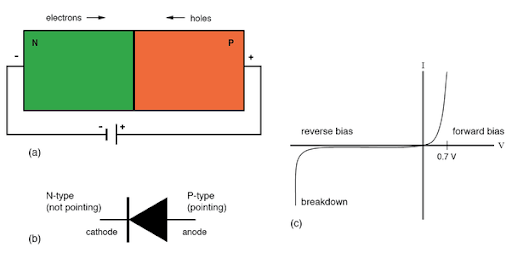Diodes are fundamental semiconductor devices that play a crucial role in electronic circuits. They are two-terminal components with unique properties that allow the flow of current in one direction while restricting it in the opposite direction. This article delves into the construction and working principles of diodes, shedding light on their significance in modern electronics.

Construction of Diodes:
Diodes are typically constructed using semiconductor materials, with silicon being the most commonly used. The basic construction of a diode involves combining two types of semiconductor materials – N-type (negative) and P-type (positive). This creates a junction, known as the PN junction, which forms the core of the diode.
N-Type Semiconductor:
N-type semiconductors are created by introducing impurities, such as phosphorus or arsenic, into pure silicon. These impurities introduce extra electrons, resulting in an excess of negative charge carriers.
P-Type Semiconductor:
P-type semiconductors are formed by adding impurities like boron or gallium to pure silicon. These impurities create “holes” or vacancies for electrons, leading to an excess of positive charge carriers.
PN Junction:
When the N-type and P-type semiconductors are joined together, a PN junction is formed. At this junction, free electrons from the N-type material move across to fill the holes in the P-type material. This creates a depletion region around the junction, where no free charge carriers exist.
Working Principles of Diodes:
The functionality of diodes is based on the behaviour of the PN junction under different conditions. Two common types of diodes, the P-N junction diode and the Zener diode, demonstrate distinct working principles.
P-N Junction Diode:
Forward Bias: When a positive voltage is applied to the P-type material and a negative voltage to the N-type material (forward bias), it reduces the depletion region’s width, allowing current to flow across the junction.
Reverse Bias: Conversely, when a negative voltage is applied to the P-type material and a positive voltage to the N-type material (reverse bias), the depletion region widens, preventing current flow.
Zener Diode:
Zener diodes are designed to operate in the reverse breakdown region. When the reverse voltage exceeds a certain threshold (the Zener voltage), the diode enters breakdown and allows current to flow in the reverse direction. This property is crucial for voltage regulation in electronic circuits.
Applications of Diodes:
Diodes find widespread use in various electronic applications, including:
Rectification:
Diodes are used in rectifiers to convert alternating current (AC) into direct current (DC) by allowing current flow in one direction.
Clipping and Clamping:
Diodes are employed to clip or limit the amplitude of signals in electronic circuits. They are also used in clamping circuits to shift the DC level of a signal.
Voltage Regulation:
Zener diodes are essential for voltage regulation, ensuring a constant output voltage in electronic circuits.
Signal Demodulation:
Diodes play a key role in demodulating signals in communication systems, separating audio or video signals from carrier waves.
Conclusion:
Diodes, as semiconductor devices, form the backbone of modern electronics. Understanding their construction and working principles is crucial for engineers and hobbyists alike, as they are integral components in electronic circuits, performing tasks ranging from rectification to voltage regulation. As technology continues to advance, diodes will continue to play a vital role in shaping the future of electronic systems and devices.




